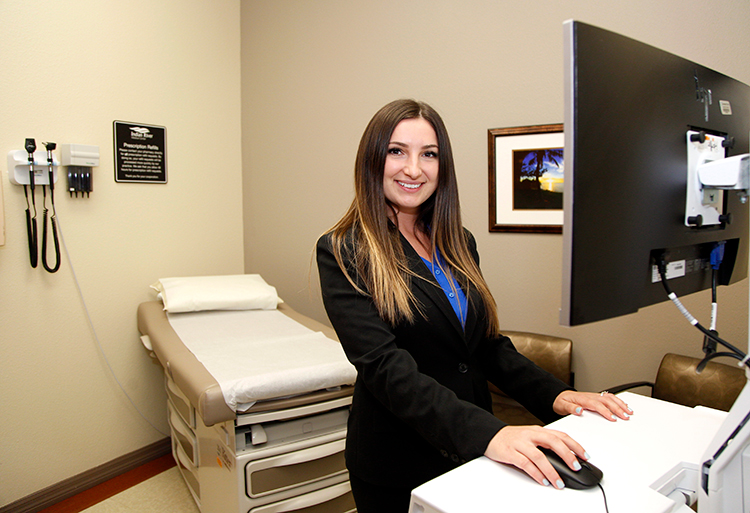
With all the talk about the COVID-19 vaccine, it’s important not to overlook another vaccine that is 97 percent effective – against shingles.
According to the Centers for Disease Control and Prevention, about 1 in 3 people in the United States will develop shingles, also known as herpes zoster, in their lifetime.
That means about 1 million people in the U.S. will get shingles each year. If you’ve ever had chicken pox – and most people have, even if they don’t remember it – you can get shingles. Plus, your risk factor for shingles increases as you get older because your immune system weakens with age.
Dr. Zhanna Grinchuk, who joined Cleveland Clinic Indian River in August, said shingles is a painful rash with blisters that develops on one side of the body. Prior to the rash outbreak people often have headaches, pain, itching or tingling in the area where it will develop.
Typically, the rash occurs in a single stripe around either the left or the right side of the body or on one side of the face.
“The shingles rash will follow a specific nerve route,” Dr. Grinchuk explained. “It won’t appear on both sides of the body. The blisters typically scab over in seven to 10 days and fully clear up within two weeks. More rare and complicated shingles are the ones that come on your face and involve the eyes and ears.
“In those cases, the patient should go to the ER because if it’s not treated immediately, it can result in blindness, hearing loss and in the most severe cases it can cause brain inflammation or encephalitis and death,” though death is rare.
“Typically, if you get the shingles rash on your abdomen it doesn’t spread to your face. It simply picks one nerve route and stays there. Fortunately, shingles is not contagious, but if you have shingles and are around someone who’s never had chicken pox or been vaccinated for chicken pox, you can actually give them chicken pox. It is the same virus.”
The most common complication of shingles is long-term nerve pain called postherpetic neuralgia (PHN). PHN occurs in the areas where the shingles rash occurred, and the pain can last for months or years. The CDC states that more than 10 percent of people who get shingles will experience PHN, and the risk increases with age.
The shingles rash can be managed with antiviral medicines that can shorten the length and severity of the illness. These medications are most effective if you start taking them as soon as the rash appears, so if you think you have shingles, see your doctor as soon as possible. Pain medicine, either over the counter or with a prescription from your doctor, may help relieve the pain. Wet compresses, calamine lotion and colloidal oatmeal may help relieve the itching.
“If you have shingles, try not to scratch the blisters because scratching will only introduce new ways of infections,” Dr. Grinchuk warned. “In those cases your doctor may need to prescribe an antibiotic to clear up the infection.”
After all that bad news about how common and uncomfortable shingles is, there is good news, too – there is a vaccine that is 97 percent effective in preventing shingles in adults 50-69 and 91 percent effective in preventing shingles in adults 70 and over.
“As a primary care doctor, I ask all my patients over 50 if they have had the shingles vaccine,” said Dr. Grinchuk. “If they haven’t I encourage them to get it in accordance with the CDC recommendation that all adults with healthy immune systems age 50 years or older get vaccinated.”
The vaccine, Shingrix, is a recombinant zoster vaccine that is licensed in the United States and recommended by the Advisory Committee on Immunization Practices to prevent shingles and its complications.
Healthy adults 50 years and older should get two doses of Shingrix, separated by two to six months. The CDC recommends that you get Shingrix even if you have had shingles, received a prior vaccine called Zostavax and if you are not sure if you had chickpox. The Zostavax vaccine is no longer available for use in the U.S. as of Nov. 18, 2020. If you had Zostavax in the past you should talk to your doctors to determine the best time to get Shingrix.
As a primary care physician, Dr. Grinchuk is trained to diagnose an array of illness and injuries for the entire family. “I see it all, from general health checkups to skin rashes to respiratory illnesses. Basically, your primary care physician is your first line of defense in diagnosing a problem and sending you to the appropriate specialist when necessary.”
Dr. Zhanna Grinchuk grew up on the west coast of Florida and is glad to be back in her home state after earning her medical degree at Ross University and completing her residency in family medicine at Carilion Clinic-Virginia Tech Carilion. Board certified by the American Board of Family Medicine, she joined Cleveland Clinic’s staff in August 2021 and is welcoming new patients at her Oslo office located at 4195 9th St. SW, Suite 106. Call 772-569-7706 to book an appointment.



